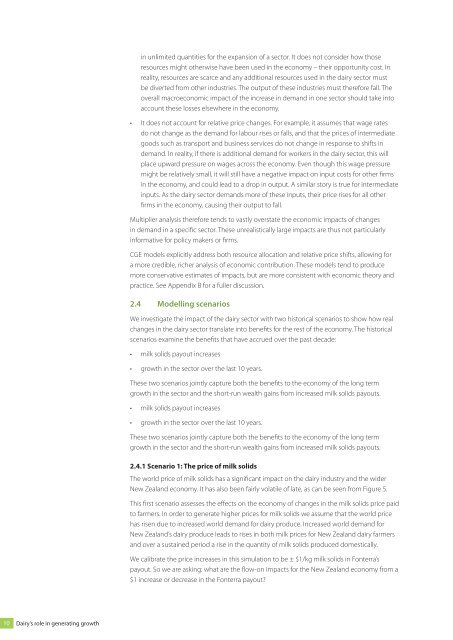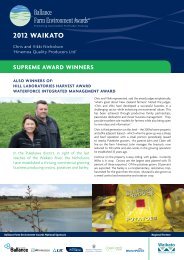Dairy's role in sustaining New Zealand - Fonterra
Dairy's role in sustaining New Zealand - Fonterra
Dairy's role in sustaining New Zealand - Fonterra
You also want an ePaper? Increase the reach of your titles
YUMPU automatically turns print PDFs into web optimized ePapers that Google loves.
10 Dairy’s <strong>role</strong> <strong>in</strong> generat<strong>in</strong>g growth<br />
<strong>in</strong> unlimited quantities for the expansion of a sector. It does not consider how those<br />
resources might otherwise have been used <strong>in</strong> the economy – their opportunity cost. In<br />
reality, resources are scarce and any additional resources used <strong>in</strong> the dairy sector must<br />
be diverted from other <strong>in</strong>dustries. The output of these <strong>in</strong>dustries must therefore fall. The<br />
overall macroeconomic impact of the <strong>in</strong>crease <strong>in</strong> demand <strong>in</strong> one sector should take <strong>in</strong>to<br />
account these losses elsewhere <strong>in</strong> the economy.<br />
• It does not account for relative price changes. For example, it assumes that wage rates<br />
do not change as the demand for labour rises or falls, and that the prices of <strong>in</strong>termediate<br />
goods such as transport and bus<strong>in</strong>ess services do not change <strong>in</strong> response to shifts <strong>in</strong><br />
demand. In reality, if there is additional demand for workers <strong>in</strong> the dairy sector, this will<br />
place upward pressure on wages across the economy. Even though this wage pressure<br />
might be relatively small, it will still have a negative impact on <strong>in</strong>put costs for other firms<br />
<strong>in</strong> the economy, and could lead to a drop <strong>in</strong> output. A similar story is true for <strong>in</strong>termediate<br />
<strong>in</strong>puts. As the dairy sector demands more of these <strong>in</strong>puts, their price rises for all other<br />
firms <strong>in</strong> the economy, caus<strong>in</strong>g their output to fall.<br />
Multiplier analysis therefore tends to vastly overstate the economic impacts of changes<br />
<strong>in</strong> demand <strong>in</strong> a specific sector. These unrealistically large impacts are thus not particularly<br />
<strong>in</strong>formative for policy makers or firms.<br />
CGE models explicitly address both resource allocation and relative price shifts, allow<strong>in</strong>g for<br />
a more credible, richer analysis of economic contribution. These models tend to produce<br />
more conservative estimates of impacts, but are more consistent with economic theory and<br />
practice. See Appendix B for a fuller discussion.<br />
2.4 Modell<strong>in</strong>g scenarios<br />
We <strong>in</strong>vestigate the impact of the dairy sector with two historical scenarios to show how real<br />
changes <strong>in</strong> the dairy sector translate <strong>in</strong>to benefits for the rest of the economy. The historical<br />
scenarios exam<strong>in</strong>e the benefits that have accrued over the past decade:<br />
• milk solids payout <strong>in</strong>creases<br />
• growth <strong>in</strong> the sector over the last 10 years.<br />
These two scenarios jo<strong>in</strong>tly capture both the benefits to the economy of the long term<br />
growth <strong>in</strong> the sector and the short-run wealth ga<strong>in</strong>s from <strong>in</strong>creased milk solids payouts.<br />
• milk solids payout <strong>in</strong>creases<br />
• growth <strong>in</strong> the sector over the last 10 years.<br />
These two scenarios jo<strong>in</strong>tly capture both the benefits to the economy of the long term<br />
growth <strong>in</strong> the sector and the short-run wealth ga<strong>in</strong>s from <strong>in</strong>creased milk solids payouts.<br />
2.4.1 Scenario 1: The price of milk solids<br />
The world price of milk solids has a significant impact on the dairy <strong>in</strong>dustry and the wider<br />
<strong>New</strong> <strong>Zealand</strong> economy. It has also been fairly volatile of late, as can be seen from Figure 5.<br />
This first scenario assesses the effects on the economy of changes <strong>in</strong> the milk solids price paid<br />
to farmers. In order to generate higher prices for milk solids we assume that the world price<br />
has risen due to <strong>in</strong>creased world demand for dairy produce. Increased world demand for<br />
<strong>New</strong> <strong>Zealand</strong>’s dairy produce leads to rises <strong>in</strong> both milk prices for <strong>New</strong> <strong>Zealand</strong> dairy farmers<br />
and over a susta<strong>in</strong>ed period a rise <strong>in</strong> the quantity of milk solids produced domestically.<br />
We calibrate the price <strong>in</strong>creases <strong>in</strong> this simulation to be ± $1/kg milk solids <strong>in</strong> <strong>Fonterra</strong>’s<br />
payout. So we are ask<strong>in</strong>g: what are the flow-on impacts for the <strong>New</strong> <strong>Zealand</strong> economy from a<br />
$1 <strong>in</strong>crease or decrease <strong>in</strong> the <strong>Fonterra</strong> payout?
















